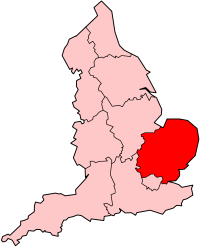Mayflower line
| Mayflower line | |
|---|---|
|
| |
| Overview | |
| Type | Heavy rail |
| Locale | Essex |
| Stations | 6 |
| Operation | |
| Opened | 15 August 1854 |
| Owner | Network Rail |
| Operator(s) | Greater Anglia |
| Rolling stock | Class 321, Class 360, Class 170 |
| Technical | |
| Line length | 11 miles 16 chains (18.02 km) |
| Track gauge | 1,435 mm (4 ft 8 1⁄2 in) standard gauge |
| Electrification | 25 kV AC OHLE |
| Operating speed | 60 miles per hour (97 km/h) |
| Mayflower Line | |||||||||||||||||||||||||||||||||||||||||||||||||||||||||||||||||||||||||||||||||||||||||||||||||
|---|---|---|---|---|---|---|---|---|---|---|---|---|---|---|---|---|---|---|---|---|---|---|---|---|---|---|---|---|---|---|---|---|---|---|---|---|---|---|---|---|---|---|---|---|---|---|---|---|---|---|---|---|---|---|---|---|---|---|---|---|---|---|---|---|---|---|---|---|---|---|---|---|---|---|---|---|---|---|---|---|---|---|---|---|---|---|---|---|---|---|---|---|---|---|---|---|---|
| |||||||||||||||||||||||||||||||||||||||||||||||||||||||||||||||||||||||||||||||||||||||||||||||||
The Mayflower line is a railway branch line in the east of England that links Manningtree, on the Great Eastern Main Line, to Harwich Town. During peak times, many services connect to or from the main line and its London terminus at Liverpool Street. The Mayflower line has six stations, including the two termini, and is situated within the county of Essex.
The route is 11 miles 16 chains (18.02 km) in length from where it branches off the main line west of the town of Manningtree to its eastern terminus in Harwich. It is part of Network Rail Strategic Route 7, SRS 07.07, and is classified as a London and South East commuter line.[1] The Engineer's Line Reference for the line is MAH.[2]
As of December 2016 passenger services on the Mayflower line are operated by Greater Anglia, which also manages all of the stations. The typical service frequency is one train per hour in each direction. The timetabled journey time between Manningtree and Harwich Town is 22 minutes.
History
The Eastern Counties Railway (ECR) had originally proposed plans to extend what is now the Great Eastern Main Line from Colchester to Harwich, although this was a cause for concern to the town of Ipswich, which was a rival port.[3]
In 1846 a railway line from Manningtree to Harwich proposed by the Eastern Union Railway (EUR) was approved by the Railway Commissioners. In 1853 an agreement was reached between the companies, with the ECR taking over the working of the EUR from 1 January 1854. The single-line branch opened on 15 August 1854.[3]
In 1862 the ECR and the EUR merged to form the Great Eastern Railway (GER).[3]
The track was doubled in 1882 by the GER, and the Manningtree North Curve which allows direct running between Ipswich and Harwich was also added at that time.
In addition to the closed station at Bradfield, there was a halt stop called Priory Halt between Wrabness and Bradfield which serviced the adjacent War Department facility; the halt station closed in 1965.[4] There was a relatively extensive system of sidings fed from a spur on the "down" (Harwich-bound) side which was controlled by a signal box which was in use from 1918 until 1966.[5] Use of the halt was confined to Admiralty employees only during various periods.
The War Department also had a munitions dump in Copperas Woods between Wrabness and Parkeston served by a spur which was situated on the north (river) side of the line just west of the point where the original alignment of the track to Dovercourt and Harwich Town had been changed when Parkeston was built. This spur was controlled by a signal box, named Primrose Box, reflecting the profusion of primroses which grew lineside in the area.[4]
The line was electrified by British Rail.
Description
The line diverges from the Great Eastern Main Line at Manningtree and is double-track for passenger services as far as Harwich International, where connecting ferry services are available to Hoek van Holland (and until 2014, Esbjerg). Beyond Harwich International, the original second track remains in place as a through-siding, but only the "up" (Manningtree-bound) line was electrified and that section to the eastern terminus Harwich Town is bi-directional.[4]
East of Manningtree there is a triangular junction that enables trains operating to the port to reach the branch from both the north and south. The line is electrified at 25 kV AC using overhead wires and has a loading gauge of W10 (excluding W9); the maximum line speed is 60 mph.[1]
The shortest platform is the "down" (Harwich-bound) platform at Wrabness, which is 90 yards (82 m) in length, meaning most services are limited to four carriages.
Battery trains

In 2015 a trial of an electric overhead wire/battery train was undertaken on the line. A single Class 379 Electrostar, after installation of electric lithium batteries were installed, began a passenger service. The train could travel up to 60 miles on energy stored in the batteries also recharging the batteries via the overhead-wires when on electrified sections of the line, at stations, and via brake regeneration.[6] Network Rail refer to this prototype model and its possible future descendants as "Independently Powered Electric Multiple Units" (IPEMU).[7]
References
| Wikimedia Commons has media related to Mayflower line. |
- 1 2 "Route 7 – Great Eastern" (PDF). Network Rail. Retrieved 2009-05-22.
- ↑ "ELR for Mayflower line".
- 1 2 3 "The Mayflower Line History".
- 1 2 3 Body, Geoffrey (1986). PSL Field Guide – Railways of the Eastern Region, vol. 1. Wellingborough: Patrick Stephens Ltd. p. 81. ISBN 0-85059-712-9.
- ↑ Mitchell, Vic (June 2011). Branch Lines to Harwich and Hadleigh. Midhurst: Middleton Press. plan V and plate 32. ISBN 978-1-908174-02-4.
- ↑ Battery train trial service launched - Global Rail News. Retrieved 2015-01-14.
- ↑ "Batteries included: Prototype battery-powered train carries passengers for first time". Retrieved 10 December 2016.
